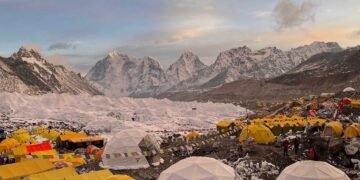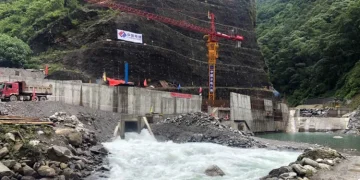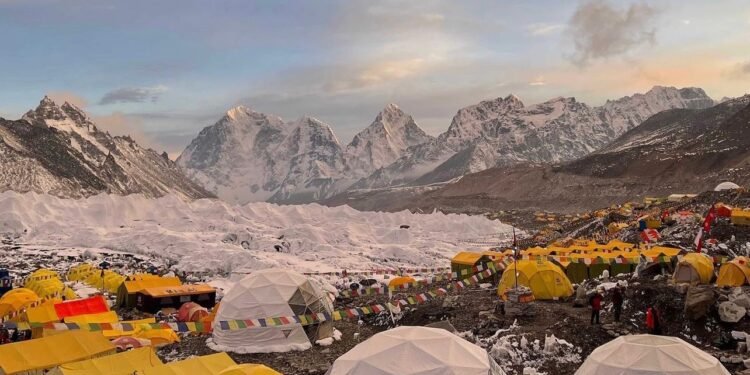Solukhumbu, Nov 12: A safer route for Mount Everest expeditions is expected to open by mid-April. The route, originally used by Sir Edmund Hillary of New Zealand and Tenzing Norgay Sherpa in the historic 1953 ascent, is gradually being restored. The trail passes through Nuptse Peak, with about 80 percent of the work already completed.
Himal Gautam, Director of the Department of Tourism, said the route is safer than the Khumbu Icefall route and is being prepared for use in the coming spring expedition. However, tourism expert Aanng Chhiring Sherpa noted that the new route is roughly 200 meters longer than the Khumbu Icefall route, which was first established in 1984.
Although the Khumbu Icefall route became the standard, the traditional Nuptse route fell into disuse despite being safer. A team of climbers and researchers including Nepali mountaineer Speedkaji Sherpa and French climbers Marc Batard and Antoine Erole has been tasked with exploring the route and recommending its reopening.
The government has not funded this project. The Ministry of Tourism is coordinating with its implementation with financial support from various French mountaineering organizations.
Climbing via the Khumbu Icefall, especially up to Camp 1, remains highly dangerous. Gautam added that more than half a dozen climbers die each year on Everest, with roughly a quarter of casualties occurring along the Icefall area, which is prone to frequent snow melting. Sherpa added that the 10-member international team has been working for three years to reopen the traditional route.
According to him preparations are moving ahead in a speedy manner to operate the climbing route within the upcoming spring climbing season.
Kaji said, “This is not just a mountain climbing route. This is the rebirth of Nepal’s history, pride, and identity, in which this time the local communities, Nepali climbers, international donors, and the Government of Nepal all collaborate. So far, 80 per cent of the entire route work has been completed. The remaining work is targeted to be accomplished by the upcoming March–April, that is, within the spring season.”
Government’s authorization
The government has granted permission to open the historic route to Mount Everest under the leadership of Kaji Sherpa and French national Marc Watay.
Director Gautam said that Sherpa and Batard’s team were given written permission for opening the route pursuant to the decision of the Federal Government’s Cabinet meeting on January 5.
Although work has progressed with financial support from various French institutions and donors, the Sherpa leading the group stated that there is support from the Department of Tourism under the federal government in terms of assistance and coordination initiatives.
The Department has granted written permission for the group led by the climbing Sherpa to extend the route and construct the climbing path up to an altitude of 6,100 metres.
“Permission has only been granted up to Camp One on Everest. There is only one route to go beyond Camp I,” said Gautam, Director of the Department of Tourism.
The Department believes that if this route is operated, it will be possible to reduce the crowding, noise and pollution currently occurring at the Base Camp during the climbing season. Gautam stated that this project, linked to Nepal’s mountaineering history, has been taken forward with the Ministry’s consent and environmental approval.
He said, “We have paid attention to all technical standards to make this new route safe and sustainable.”
A model of local and international cooperation
Experts say that the special feature of this campaign is that it is not just a government project but also connected with the country’s history. The Himalayan Expedition, Lumbini Development Trust’s goodwill ambassador, and Greece’s Consul Bikram Pandey Kaji have also contributed financially in this campaign.
Sherpa stated that the then Director General of the Department of Tourism, Dr Narayan Prasad Regmi, actively supported in technical and policy coordination for the initiative.
Antonio Herod from France has also joined the team and is working with them. “This is not just route construction, it is the restoration of Nepal’s ancient relationship with the world’s climbers,” Herod said. According to him, about 220 steps have been constructed so far.
“This lays the foundation for the fixing of safety ropes and ladders used in climbing. Out of a total of about 270 steps to be made, the work on the remaining 50 is planned to be completed by the coming months of Falgun and Chaitra,” he said.
Estimated cost of route construction is 400 thousand USD
It is estimated that it will cost about 400 thousand US Dollars to fully construct this route. So far, 300 thousand dollars have been spent, said Sherpa. He said that the remaining 100 thousand dollars is being collected by donors.
“The main support has come from mountaineering enthusiasts and private donors from France. Besides the construction of the fixed route, this amount is being used for the construction of climbing steps, safety management, technical equipment and clearing the route,” Sherpa added.
New route: Less risk, more safety
The new route is being developed as an alternate route to existing Khumbu Icefall Route. The Khumbu icefall is considered one of the most danger routes. The mountaineers frequently face tragic incidents and some of them unfortunately loss their lives along the route due to icefall and ice block, said director at the department Gautam. Annually, 500 foreign and 300 plus Nepalis receive permission for mountaineering.
Gautam further shared that the purposed new route is 200 meters long in the distance compared to the previous one but is safe and is expected to lessen the risk of possible natural and human disasters. Tourism entrepreneurs Aang Chhiring Sherpa remarked that the new route will bring positive vibes and revolution in the mountaineering sector drawing the attention of foreigners. The enthusiast in the sector has termed it as ‘historic route revival’.
Dawa Sherpa, a tourism entrepreneur of Sagarmatha (Mt Everest) region, said, “With the re-opening of this route, the employment of Nepal’s guides, porters and local businessmen will increase. Sagarmatha will once again become the centre of world mountaineering. “The self-esteem of the Nepali people reached the world when Tenzing Norgay and Edmund Hillary climbed Mount Everest in 1953, a rebirth of history, culture and self-esteem.
Sagarmatha climber Temba Chiri Sherpa said, “Everyone has the feeling that the path that has been walked is being reopened, that it has revived the glory.”





















